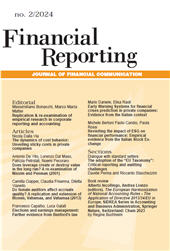Early Warning Systems for financial crises prediction in private companies : evidence from the Italian context
133-161 p.
Purpose: This study compares models for predicting business financial crises, focusing on which are most effective. In light of the new European Directive on business failure, it highlights a trade off between predictive accuracy and timeliness in static models and offers an alternative approach.Design/methodology/approach: This study examines the Italian early warning system (EWS), testing static alert indicators' predictive ability on a large sample of private companies. It then proposes a dynamic version of the EWS.Findings: The results show a trade off between predictive ability and timeliness for static models. In contrast, a dynamic system is more accurate in predicting crisis events, allowing managers to take corrective actions. Originality: The results highlight the limitations of static prediction models and emphasize the potential of a simple dynamic model that is specifically designed for small and medium sized entities (SMEs).
Practical implications: This study proposes a dynamic model tailored for SMEs, which are particularly vulnerable to financial crises. This insight can help managers and policymakers balance accurate predictions with timely interventions, especially in European countries implementing crisis prediction models. [Publisher's Text].
-
Articles from the same issue (available individually)
-
Information
ISSN: 2036-6779
KEYWORDS
- corporate failure, early warning systems, crisis, crisis prediction


